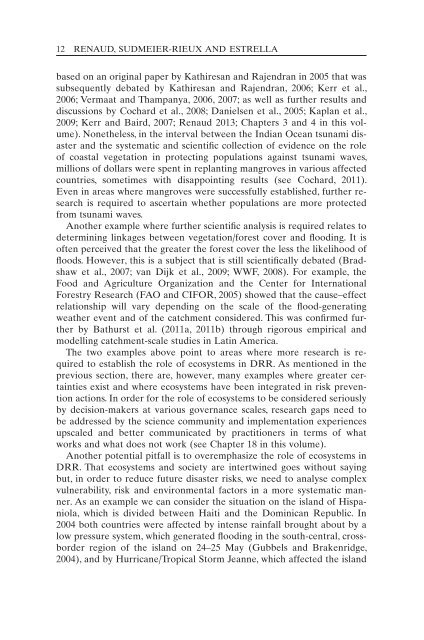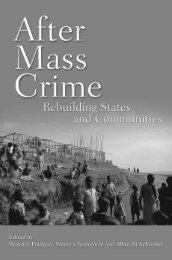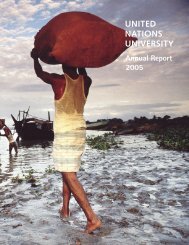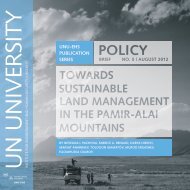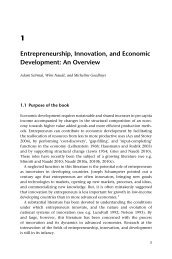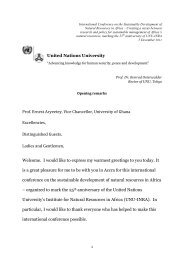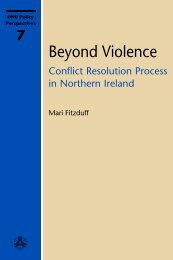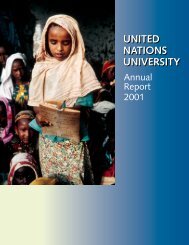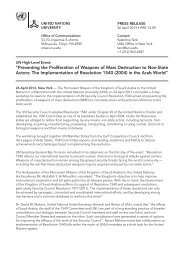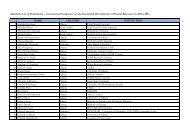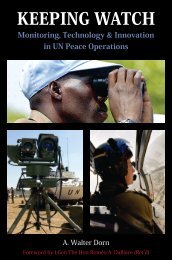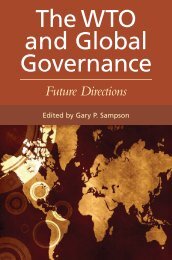Sample Chapter - United Nations University
Sample Chapter - United Nations University
Sample Chapter - United Nations University
You also want an ePaper? Increase the reach of your titles
YUMPU automatically turns print PDFs into web optimized ePapers that Google loves.
12 RENAUD, SUDMEIER-RIEUX AND ESTRELLA<br />
based on an original paper by Kathiresan and Rajendran in 2005 that was<br />
subsequently debated by Kathiresan and Rajendran, 2006; Kerr et al.,<br />
2006; Vermaat and Thampanya, 2006, 2007; as well as further results and<br />
discussions by Cochard et al., 2008; Danielsen et al., 2005; Kaplan et al.,<br />
2009; Kerr and Baird, 2007; Renaud 2013; <strong>Chapter</strong>s 3 and 4 in this volume).<br />
Nonetheless, in the interval between the Indian Ocean tsunami disaster<br />
and the systematic and scientific collection of evidence on the role<br />
of coastal vegetation in protecting populations against tsunami waves,<br />
millions of dollars were spent in replanting mangroves in various affected<br />
countries, sometimes with disappointing results (see Cochard, 2011).<br />
Even in areas where mangroves were successfully established, further research<br />
is required to ascertain whether populations are more protected<br />
from tsunami waves.<br />
Another example where further scientific analysis is required relates to<br />
determining linkages between vegetation/forest cover and flooding. It is<br />
often perceived that the greater the forest cover the less the likelihood of<br />
floods. However, this is a subject that is still scientifically debated (Bradshaw<br />
et al., 2007; van Dijk et al., 2009; WWF, 2008). For example, the<br />
Food and Agriculture Organization and the Center for International<br />
Forestry Research (FAO and CIFOR, 2005) showed that the cause–effect<br />
relationship will vary depending on the scale of the flood-generating<br />
weather event and of the catchment considered. This was confirmed further<br />
by Bathurst et al. (2011a, 2011b) through rigorous empirical and<br />
modelling catchment-scale studies in Latin America.<br />
The two examples above point to areas where more research is required<br />
to establish the role of ecosystems in DRR. As mentioned in the<br />
previous section, there are, however, many examples where greater certainties<br />
exist and where ecosystems have been integrated in risk prevention<br />
actions. In order for the role of ecosystems to be considered seriously<br />
by decision-makers at various governance scales, research gaps need to<br />
be addressed by the science community and implementation experiences<br />
upscaled and better communicated by practitioners in terms of what<br />
works and what does not work (see <strong>Chapter</strong> 18 in this volume).<br />
Another potential pitfall is to overemphasize the role of ecosystems in<br />
DRR. That ecosystems and society are intertwined goes without saying<br />
but, in order to reduce future disaster risks, we need to analyse complex<br />
vulnerability, risk and environmental factors in a more systematic manner.<br />
As an example we can consider the situation on the island of Hispaniola,<br />
which is divided between Haiti and the Dominican Republic. In<br />
2004 both countries were affected by intense rainfall brought about by a<br />
low pressure system, which generated flooding in the south-central, crossborder<br />
region of the island on 24–25 May (Gubbels and Brakenridge,<br />
2004), and by Hurricane/Tropical Storm Jeanne, which affected the island


